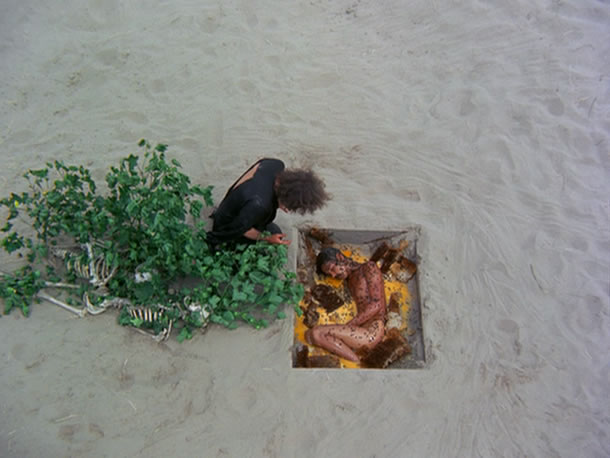Alejandro Jodorowsky began his career with an already well-defined style, utilizing extensive surrealism and a bizarre setting in his debut La Cravate, and then moving further into the surrealist aspect with the nonstop grotesqueries of his first feature Fando Y Lis. One of the few traits those films shared was their loose narrative structure. Neither film has a story that is truly affecting, as Jodorowsky tended to lean heavier on moods and visuals to elicit audience reaction. However, his next and best known feature, El Topo, evades the haphazard plotting of his prior works in favor for a more concrete and emotional tale. Yet, in line with his initial forays into filmmaking, Jodorowsky keeps his surrealist bend intact, demonstrating full control of his Dali-esque visuals to craft a tale that is simultaneously campy and wholly invocational.
El Topo, in essence, is a genre film through and through. This was the film that really helped Jodorowsky jump into the limelight, essentially creating the now-cinema-staple of the midnight movie. El Topo is a surrealistic take on the Western, featuring a renegade-turned-mystic in his journey to find enlightenment. While this did mark Jodorowsky’s first foray into populist film genres, it also set the stage for one of his most prominent recurring themes: Religion and spirituality,
The first segment of the film involves the titular gunslinger in a journey to kill the four great gun masters. A blood-soaked tale of revenge and twisted symbolism, this section is a straight western, with some very distinct characteristics setting it apart. First and foremost, the film’s religious connection is blatantly apparent from nearly the beginning of the film, with the titular character even going so far as to call himself a god.
In one of the earliest scenes, El Topo and his son wander into a small village where an apparent slaughter has taken place. Upon walking into the local church, they see bloodied corpses dangling from the rafters. While the gruesome killings may seem like the more important matter, Jodorowsky’s choice of a church for the locale of this monstrosity is crucial. Before the villains are revealed in any tangible form, El Topo cements their disregard for the sanctity of religion and religious artifacts. This theme of religious desecration comes in again only a few scenes later.
As El Topo continues his quest to find the village's murderers, he comes across a group of them left behind, hanging around in the mountains. One of the men is sniffing and snacking on a pile of women’s shoes, while another is gluttonously devouring food. Along with the four gun masters and the rest of the murderers, these begin one of the religious motifs of the film: The seven deadly sins. Gluttony, Lust, Avarice, Envy, Wrath….all seven are representing one form or another as the antagonists of the film.
This is where the previous note of religious desecration comes back into play. El Topo and his son come upon a small monastery as they seek the murderers, and see a group of the killers tormenting the locals. One sits and tears away pages of a bible, while another makes flirtatious movements toward a statue of the Virgin Mary. This sequence comes to head when the killers strip a group of monks and ride them around the grounds like horses, ripping the skin off of their bare rear-ends. Jodorowsky hits hard on these anti-religion visuals, and by doing so creates a new message. The deadly sins, personified by the villains of the film, do nothing but harm religious sensibilities and ideals while searching to feed their ever growing desires.
However, this theme doesn’t stay for the entire film. At the end of the first half, after killing the last of the gun masters, El Topo becomes wracked with guilt. Betrayed by his companions, he turns arounds and heads in the direction of his victims. He finds one corpse after another, and with each he discovers small populations of bees living inside of the remains. This is, in fact, a call to a story in Judges 14, where the corpse of a lion killed by Samson is filled with a beehive and a plethora of honey.
This may seem like a harrowing piece of imagery, but it’s quite simple. Here, El Topo has realized that his journey of revenge and destruction was ill-fated, and in regret, turns to retreat along his path. While Jodorowsky initially displayed these seven deadly sins as banes of religion and spirituality, here the argument seems to have switched. Instead, El Topo has come to the realization that to reach true enlightenment, one must learn to accept and understand the sins instead of just outright destroying them. This leads to the second half of the film, which forgoes the revenge narrative for a tale of spiritual understanding and redemption.
Part two coming soon...


